Invasive weeds with purple flowers are common across many landscapes and can cause substantial damage to native plants and ecosystems.
These weeds are hardy and fast-growing and can spread rapidly if left unchecked. They often out-compete native species for resources like sun and water, disrupting the natural landscape.
Additionally, they can be harmful to other plants and animals. It is, therefore, important to identify and control invasive weeds to preserve native plant species and maintain the balance of the local ecosystem. Here are some,
20 Common Invasive Weeds With Purple Flowers
1. Canada Thistle

Scientific name: Cirsium arvense (L.) Scop.
Canada thistle is a prolific and aggressive invasive weed with a purple flower native to Europe that got introduced to North America in the 1600s.
This plant heavily produces seeds and can also spread by roots. Seedlings sprout as small rosettes in the fall or early spring, and flowers develop in late June and bloom between July and August.
The leaves are normally lance-shaped, irregularly lobed, with wavy toothed margins in an alternating pattern.
You can easily recognize Canada Thistle in mid-July when flowers change to seed heads with fluffy white tops.
2. Red Clover

Scientific name: Trifolium pratense
Red clover is a common invasive weed belonging to the legume family.
It has since become a highly invasive species, spreading across much of the country and becoming a major problem for farmers. Unlike many other weeds, the Red clover has plenty of benefits to humans and live stocks.
To humans, Red clove can treat whooping cough, cancer, skin inflammation, and other conditions such as eczema.
Cattle and other animals also graze on it. The many benefits that come with it bring out debate about whether it is a weed a lot. But since the plant competes with other vegetation for resources, it had to make it to the list.
3. Musk Thistle

Scientific name: Carduus nutans L.
Musk thistle is a long-lived, biennial weed mainly found in some parts of Washington State.
The plant thrives in full sun and moist soil and is often found in disturbed areas, along roadways, and in agricultural fields.
Musk thistles can grow over 7 feet tall, with a hairy and spiny stem in their second year of growth. The flowers fall on the side when they mature, just like the sunflowers.
The effects of Musk Thistle in meadows, pastures, and other forage species can be catastrophic. Remember that one plant can produce more than 20,000 seeds; talk about being invasive!
4. Purple Prairie Clover

Scientific name: Dalea purpurea
The Purple Prairie Clover is one of the sturdiest weeds. Its adaptations allow it to survive and thrive in tough climates. The weed typically does well in dryer areas. It has a USDA zone rating of seven to ten.
The weed’s rich purple flowers are a source of nectar to hummingbirds, bees, and other insects. They form an essential part of the ecosystem in areas where they occur naturally.
The weeds have agricultural applications. Farmers use them as pre-cultivation plants since they have rhizobia. Rhizobia is nitrogen-fixing bacteria that enrich the soil and is an alternative to synthetic fertilizers.
5. Purple Dead Nettle
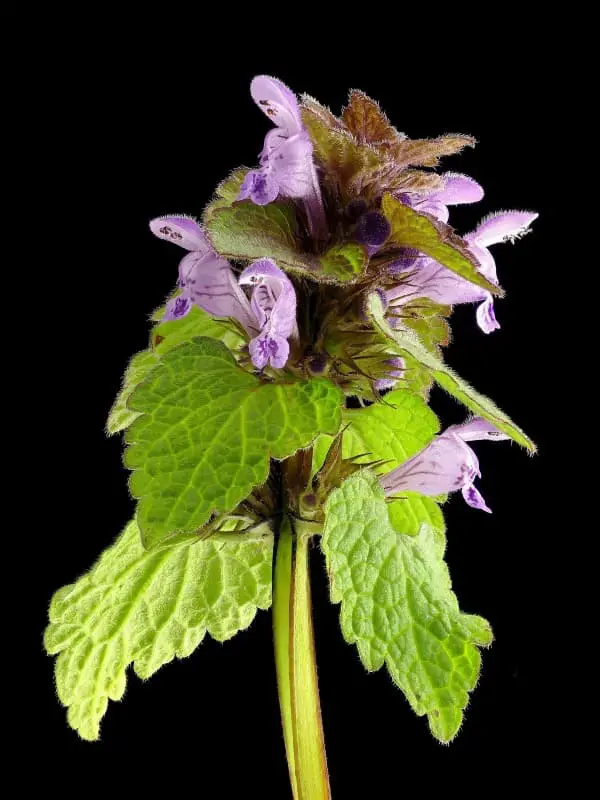
Scientific name: Lamium purpureum
It is a resilient weed that is native to Europe and Asia. The weed typically blossoms biannually in the summer and winter. The perennial plant produces purple flowers that bear nectar. They attract bees, insects, and hummingbirds when these flowers sprout.
Purple dead nettle is generally resilient and does not have specific soil considerations. They, however, tend to thrive in well-drained and slightly moist soils.
The species is relatively easy to control. Most common weed prevention methods like plowing and mulching should work.
6. Ground Ivy
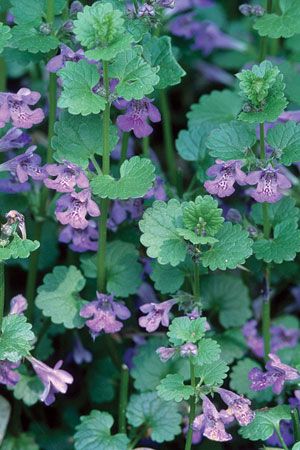
Scientific Name: Glechoma hederacea
Ground ivy is one of the toughest weeds to eliminate. The mint species spread rapidly and are known to survive the weakest killing techniques. The plant produces petals that resemble lobes.
These plants are beneficial to other species. Their roots contain rhizomes, which affix nitrogen to the soil.
Ground Ivy does have some culinary applications. You can add it to salads or cook them like spinach.
They have anti-inflammatory applications and could help reduce swells and welts.
7. Forget-Me-Nots

Scientific Name: Myosotis sylvatica
Many gardeners plant these weeds because of their aesthetics. They can, however, grow rapidly out of control if you don’t actively trim them.
It would help if you managed them actively, as they tend to spread quickly. Forget-Me-Nots are some of the most useful weeds, as they have many applications.
They get used in the bakery industry to make cookies and cakes. You can also add them to beverages like tea, which has taste-enhancing properties.
8. Black Nightshade

Scientific Name: Solanum nigrum
The black nightshade is a seasonal herb that sprouts in the spring and dies in winter. They are known for their apical dominance, which can be a threat, especially to shorter plants, as it tends to deprive them of nutrients.
The weeds are relatively easy to manage. Mulching and uprooting the weed should be enough, and chemical weed killers work great.
The weed is known to be toxic and has no proven uses. It grows tall under the right conditions.
9. Canada Thistle
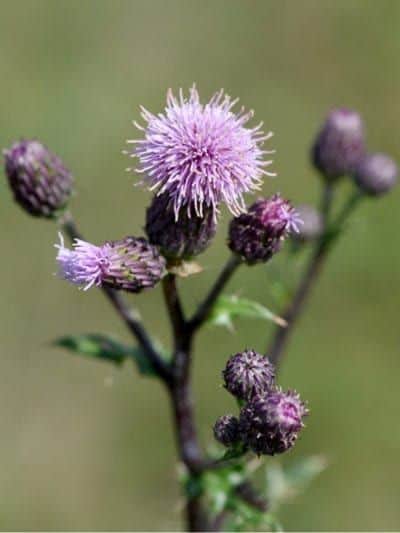
Scientific Name: Cirsium arvense
The Canadian Thistle is a woody plant that has pine-shaped flowers. These flowers grow rapidly and spontaneously during the summer. The plant has several adaptations that make it hard to eliminate.
Their dandelion-like seeds allow the plant to spread rapidly. Their anchor roots also make them difficult to uproot using conventional means.
The weed has some medical applications. Native Americans use it to ease stomach discomfort. The plant’s leaves are edible, and you can eat them without cooking.
10. Bull Thistle

Scientific Name: Cirsium vulgare
The bull thistle is a common species. Its unique appearance distinguishes it from most other thistle species. It has rich purple flowers at the end of a spiny spherical structure.
The plant’s growth is difficult to control since it is wind pollinated. It can spread quickly if left unregulated. Its vibrant color attracts some insects like butterflies, which makes it much harder to control its spread.
The plant has some medical applications; you can use it to treat stomach upsets.
11. Henbit

Scientific Name: Lamium amplexicaule
Henbit is a unique flowering weed, easily distinguishable by its hairy flowers. The plant’s adaptations allow it to thrive in diverse climates. Unlike most weeds, the henbit does not spread rapidly. The weed typically grows better in ponds and other mushy areas.
Henbit is easier to manage than most weeds. Common techniques like uprooting and spraying should do the trick. They also don’t grow rapidly, making regulating them easy.
The weed has several culinary applications.
12. Healall

Scientific Name: Prunella vulgaris
The healall plant is a short weed with thick stems that commonly grows in woodland areas. It has leaves and stems covered with tiny pin-like structures.
The species grows rapidly, especially under the right conditions, and could take over your garden fast.
It is difficult to eliminate the weeds because their roots grow very deep. The weed has many medical applications. It has anti-inflammatory properties useful for managing welts and superficial swells. It also helps with stomach upsets.
13. Violet Woodsorrel
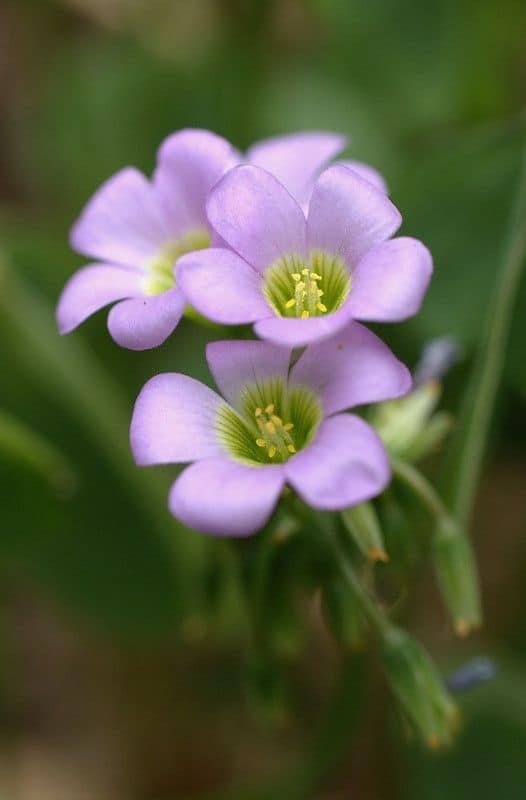
Scientific Name: Oxalis violacea
Violet Woodsorrel is a weed native to North America. The plant produces large purple and yellow flowers. Farmers use the plant before they cultivate it because it has rhizomes.
The bacteria enriches the soil with nitrogen, which other plants can synthesize.
The creeping woodsorrel species is one you want to avoid. It grows rapidly and takes over flowerbeds, gardens, and large tracts of land.
It isn’t easy to eliminate by conventional means. You would need herbicides to eliminate the weeds.
14. Dove’s Foot Crane’s Bill

Scientific Name: Geranium molle
Dove’s Foot is a perennial weed that originates from the Mediterranean region. The species grows on all continents but in Antarctica. The plant has a green stem with tiny sharp pines.
The invasive species spread quickly. Unlike other weeds, it does not harm other plant life. It is difficult to eliminate. You will have to invest heavily in herbicides.
The plant is quite resilient and does well in most soils and climates.
15. Creeping Charlie

Scientific Name: Glechoma hederacea
Creeping Charlie is indigenous to Europe. It has been naturalized in nearly all continents,
The Creeping Charlie plant is one you don’t want the misfortune of dealing with. It is one of the most resilient weeds with purple flowers.
The sturdy plant has deep roots, which makes it difficult to deal with. It also resists many strong herbicides and weed killers. The plant has no known benefits or industrial or medical applications.
16. Wild Violets

Scientific Name: Viola Odorata
These are tiny plants that are native to Europe and Asia. They appear to have no real stems and sprout close to the ground and on tree bark.
Don’t let the diminutive nature of the plant fool you; these weeds take over gardens quickly. They grow aggressively and spread their seeds over vast areas.
People sometimes grow the weed in isolated areas on their property because of the flower’s aesthetic. It would help if you managed them to avoid uncontrolled spreading.
17. Spotted Knapweed

Scientific Name: Centaurea maculosa
The Spotted Knapweed is a seasonal weed that dies down during the winter. It resembles a thistle but is of a different genus and species.
The plant is fairly common in North America. It typically grows around woodlands and grasslands.
Dealing with the weed can be challenging, considering how fast it spreads. A plant could produce tens of thousands of seeds, making weed management difficult. It is difficult to eradicate since it is resistant to some herbicides.
18. Spear Thistle
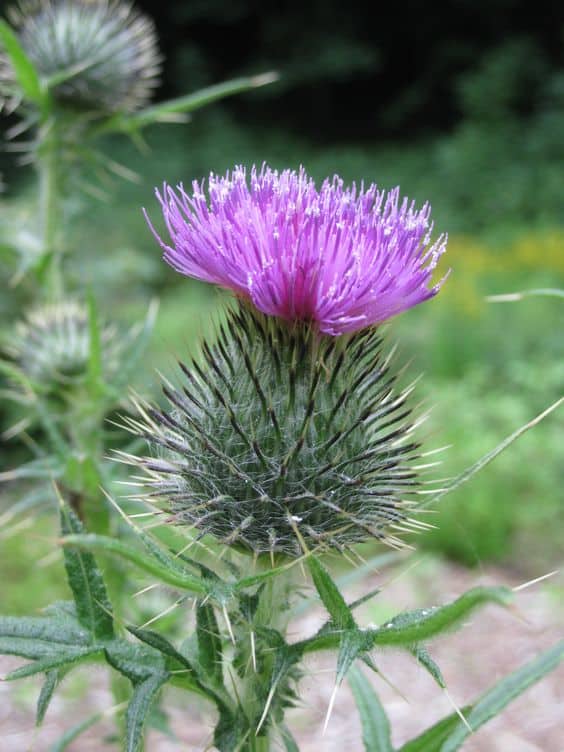
Scientific Name: Cirsium vulgare
Its distinct appearance sets it apart from the majority of other thistle species. It has rich purple flowers that grow at the end of a spiny shell. Because it is wind pollinated, the plant’s growth is difficult to control.
If left unchecked, it can quickly spread. Its vibrant color draws some insects, such as butterflies, making it much more difficult to control its spread. The plant has some medicinal properties; it can treat stomach upsets.
19. Black Nightshade

Scientific Name: Solanum nigrum
It is a perennial weed that sprouts during the spring. Black Nightshades don’t grow taller than two feet. It is a harmful plant to gardens and contains toxins that affect humans.
The Black Nightshades resemble a species known as the edible nightshade. The black nightshade is, however, poisonous and not fit for consumption.
To manage the weed’s growth, you must uproot the individual plants. They spread quickly if you don’t manage them.
20. Purpletop Verbena

Scientific Name: Verbena bonarienasis
It is a weed that is native to Australia. The plant produces beautiful small flowers that grow in clusters on bulbous stems. Many gardeners use plants to line their flower beds because they have a beautiful aesthetic.
You must be careful in managing the plant’s growth, as they can get out of control quickly. They are not hard to manage but tend to take over gardens if left to grow independently.
Conclusion
Invasive weeds with purple flowers can be a significant problem in many regions, as they can cause substantial damage to native ecosystems.
It is important to identify and control these weeds and other invasive plants to protect local plant species and ecosystems.
The above list of invasive weeds with purple flowers can be helpful for gardeners and landscapers who need to identify and deal with these weeds.
 Being Human
Being Human




